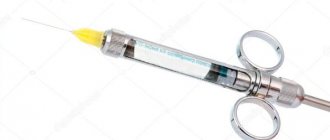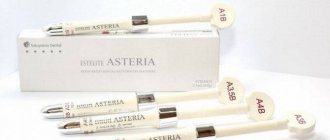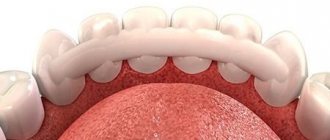Conduction anesthesia is considered the most effective method of pain relief in dental practice. The essence is to block nerve impulses that are directly responsible for pain syndromes in the brain.
After the administration of the anesthetic, the pain threshold is reduced to zero. This allows the necessary operation to be carried out smoothly. The advantages of this method are good tolerability and high efficiency. In addition, after the intervention, the pain syndrome continues to remain at a minimal level.
Features and principle of action of conduction anesthesia
Conduction anesthesia is a local anesthesia and involves the introduction of a drug into the peripheral region of the nerve that ensures the functioning of this part of the body. Dentists in most cases use conduction anesthesia to treat teeth located in the lower jaw.
The technique is aimed at blocking impulses transmitted from nerves to the brain. As soon as the drug enters the nerve, sensitivity is reduced to a minimum level. The duration of action of the anesthetic depends on the substance used.
A number of features of conduction anesthesia can be distinguished:
- The injection is carried out with drugs, the concentration of which reaches 2%. Compared to other methods of pain relief, the content of active substances is at a high level.
- Loss of sensitivity does not occur at the site of drug administration, but in the nerve that is located in this area of the body.
- Conduction anesthesia has a minimal number of complications and side effects.
- The method allows you to control the duration of pain relief and the area of effect of the drug.
Available techniques
Conductive mandibular anesthesia is carried out in several ways: intraoral and extraoral. The first option, in turn, is divided into types:
- palpable;
- modified apodactyl method of Verlotsky;
- apodactyl.
Extraoral techniques: modified subzygomatic method of Egorov, Uvarov, Bershe-Dubov, Bershe, retromaxillary and submandibular methods. If the patient’s ability to open his mouth is limited (for example, with a broken jaw), then conduction anesthesia is performed using the Akinosi method. The patient closes his teeth with his mouth closed, the puncture is made at the level of the buccal mucosa and molars of the upper jaw.
For manipulations, you need to use high-quality needles, strictly adhere to the technique, do not insert the needle to the cannula and do not make sudden movements of the syringe. If part of the needle breaks off and remains in the tissue, then its removal is possible only in a hospital setting after a thorough X-ray examination.
Indications for conduction anesthesia
- Implantation.
- Carrying out surgical intervention (removal of cysts, granulomas, ulcers and benign neoplasms).
- Therapy of dental diseases.
- Preparation before surgery.
- Removal of teeth or roots.
- Inflammation in the oral cavity.
- Carrying out preventive procedures to prevent periodontal diseases and caries.
- Inability to use general anesthesia.
Intraosseous anesthesia
Intraosseous anesthesia in dentistry is chosen when infiltration or conduction anesthesia is ineffective. It is usually performed in the area of the lower molars and is indicated for treatment, tooth extraction and operations on the alveolar process. However, it is rarely used due to the complex technique of execution: it is necessary to dissect the mucous membrane, then make a hole in the bone with a special bur with a diameter equal to the size of the syringe needle in order to direct the syringe directly to the spongy substance. The drug should be administered slowly, under high pressure.
Among the advantages of this type of anesthesia is significant efficiency; a small amount of even a weak anesthetic is sufficient. Among the disadvantages are the complexity of implementation, as well as serious risks of complications if the drug enters the bloodstream, which is likely due to accidental damage to a vessel.
Contraindications to conduction anesthesia
- Poor blood clotting. This feature can lead to bleeding.
- Allergy to used painkillers.
- Disorders of the cardiovascular system (arrhythmia, ischemia, tachycardia, heart valve defects, etc.). These pathologies are not compatible with adrenaline, which can be used to constrict blood vessels.
- The presence of inflammation or ulcers at the injection sites of the anesthetic drug.
- Open wounds, infectious inflammations and contaminated wound surfaces on the patient’s extremities.
- Childhood.
- Mental disorders, unstable psycho-emotional background of the patient.
- Patient refusal to use this type of anesthesia.
Local anesthesia in dentistry: types and preparations
In dentistry, both therapeutic and surgical, different types and techniques of anesthesia are used, for example, conduction, infiltration, intracanal, intraosseous, intraligamentary (intraligamentous), tuberal and others. Their differences lie in the place of application and in some features of their effects. As a rule, modern dental clinics in Moscow use carpule anesthesia. This means that the anesthetic is supplied in disposable carpules - a kind of cartridges with an anesthetic solution that are inserted into syringes with screw-on disposable needles. Due to this, the carpules remain sterile, since the dentist does not have to open them, thereby eliminating contact of the medicine with air.
Methods of administering conduction anesthesia
Methods of administering conduction anesthesia can be divided into 2 groups:
- Extraoral. Used in the presence of inflammatory foci in the oral cavity. These include:
- Submandibular. The pain medication blocks the inferior alveolar nerve.
- Podzykulova. The drug is injected under the edge of the cheekbone arch.
- Mandibular. The mandibular foramen loses sensitivity.
Once the anesthetic is injected into the treated area, the numbing effect occurs within 15 minutes. The duration of the anesthetic effect depends on the type of medication used.
- Intraoral. These include:
- Apodactylous. The alveolar nerve is blocked.
- Torusal. The anesthetic is injected into the mandibular ridge. Molars and premolars lose sensitivity.
- Tuberal. Anesthesia is injected into the area of the molars located on the upper jaw.
- Infraorbital. It is used to block sensitivity in the anterior wall of the maxillary bone, mucous membrane and alveolar process.
- Palatine. The palate and alveolar process are anesthetized.
- Incisive. The anesthetic is injected between the upper canine and incisor. The hard palate, nasopalatine nerve and soft tissues surrounding the tooth become numb.
When administered intraorally, the effect occurs 10 minutes after injection.
Preparation for conduction anesthesia
Before performing the operation under general anesthesia, it is necessary to undergo a standard examination. During diagnosis, special attention should be paid to the patient’s neurological condition, his psyche and behavior.
Before the procedure, the specialist will explain in simple, accessible words about the sequence and method of administering anesthesia, as well as the sensations that may accompany the patient during pain relief. In addition, the doctor will definitely check the patient’s reaction to the anesthetic drug to make sure there is no allergic reaction.
The anesthesiologist must follow the rules when administering conduction anesthesia:
- First of all, it is necessary to numb the skin using a gentle method.
- The needle must be fixed in a strictly defined place in order for the anesthetic to reach the desired area.
- Paresthesia must be present. It indicates that pain relief was carried out correctly and sensitivity has decreased.
- Drugs should be administered in portions with aspiration samples to prevent them from entering the bloodstream.
- During anesthesia, it is necessary to continuously monitor the patient's blood pressure and pulse.
- The room in which the procedure is performed must be equipped with all the necessary instruments for pain relief, as well as means of resuscitation and treatment of possible complications.
Stages of administration of conduction anesthesia
- A consultative appointment, during which a specialist determines the presence of chronic diseases and evaluates test results that may become contraindications to pain relief.
- Detection of nerve endings that need to be anesthetized.
- Disinfection of the skin puncture area with a special solution.
- Injection of anesthetic into certain areas. At the same time, the rate of administration of the anesthetic is observed and the volume of the injected substance is controlled.
- Monitoring the patient after pain relief.
- Before the start of surgery, the patient is asked control questions to determine the level of sensitivity.
The duration of the analgesic effect depends on the drug used and its dosage. Modern painkillers retain their effect for up to 40-60 minutes.
General overview
The introduction of an anesthetic composition into the area under the eye socket, or infraorbital anesthesia, belongs to the category of local anesthesia techniques. When using modern anesthetics, nerve blockade is achieved by depositing a solution at the entrance to the infraorbital area. The anesthetic channel is formed in the area of the nerve that conducts pain sensitivity, which makes it possible to block the corresponding reactions in a number of areas:
- Elements of the maxillary row - with the exception of the frontal incisors and second premolars;
- In the upper lip, cheek, lower eyelid and under the eye socket;
- In the maxillary sinuses (in the structure of both bone and mucous tissues);
- On the lateral surface of the nasal passage.
The result provides conditions for medical intervention and eliminates the patient’s feeling of severe pain.
Drugs used
The success of conduction anesthesia depends not only on the technique used, but also on the drugs used. The following medications are used for this pain relief technique:
- Solutions of the Articaine series. They have a long lifespan and high efficiency. These include:
- Ultracaine.
- Septanest.
- Ubistezin.
- Lidocaine. It is a highly effective anesthetic and at the same time contains a minimal amount of toxic substances.
- Melivacaine. The duration of action of this drug is about 40 minutes. Melivacaine has no contraindications for use.
- Novocaine. This is perhaps the most frequently used remedy. It is characterized by low toxicity and rapid hydrolysis in the body.
Intraoral technique
If altered variations are not taken into account, then this technique can only be performed apodactylally or with palpation.
Apodactyl
The dentist uses this technique to focus on the pterygoid fold of the mandible. A syringe with an anesthetic is placed opposite the small molars or the first large tooth. You need to prick directly into the center of the fold in the area of the triangular slope. After the puncture, the needle is advanced all the way into the bone, and about two millimeters of solution is released into this part. Next, the syringe is moved to the other side at the level of the incisors. The needle in this position is advanced 2 cm, at this depth another milliliter of anesthesia is injected. The effect of the injection appears after 5-8 minutes.
With palpation
To administer anesthesia, the doctor palpates the site of the future injection and determines the location of the temporal ridge. The syringe is placed at the same level with the first molar on the opposite side. The needle is placed slightly above the chewing surface of the outermost tooth of the lower row by about one centimeter. Afterwards, a milliliter of anesthetic is injected into the tissue. Next, the syringe is transferred to the other side and placed over the incisors. At a depth of two centimeters, the remaining anesthetic is injected into the tissue.
There are a lot of extraoral techniques for mandibular anesthesia. Techniques have changed and improved, but they all involve external anesthesia of the nerves, that is, administration of the drug through the tissues of the oral cavity.
Advantages and disadvantages of conduction anesthesia
Advantages:
- The drug can be administered outside the surgical site.
- Anesthesia has a long-lasting effect. A specialist can monitor the duration of action of the medication.
- To achieve the desired effect, small doses of painkillers are sufficient.
- There is no deformation of soft tissues in the operated area.
- When exposed to conduction anesthesia, salivary activity decreases.
- The technique is safe, so it can be used from the age of 12, and also in some cases in pregnant and lactating women.
- The cost of the procedure is affordable.
Flaws:
- In order for anesthesia to pass without complications, the specialist must have certain skills and sufficient experience.
- There is a high probability of the anesthetic entering a blood vessel.
- Restricted use by age (only from 12 years old).
- Risk of injury to nerves or blood vessels.
Intraligamentary anesthesia
Intraligamentary anesthesia is also called intraligamentous and intraperiodontal. Its difference is in higher pressure when administering an anesthetic, which ensures uniform spreading of a small amount of the drug in the periodontal space, as well as its penetration into the intraosseous space. Drugs should be administered very slowly. When using this type of anesthesia, significantly less drug is required than with conventional infiltration; it occurs within 15-45 seconds and lasts for 20-30 minutes. For intraligamentary anesthesia, special syringes are often used, which make it possible to administer the drug under the required pressure without unnecessary effort and thus achieve the best result.
Possible complications
In the practice of specialists at the World of Dentistry clinic, severe complications after conduction anesthesia occur in extremely rare cases. Negative effects include neuropathy and an inadequate response of the body to the administered drug. Complications that are normal and go away on their own include:
- Muscle weakness.
- Goosebumps effect.
- Partial loss of sensitivity.
The above symptoms disappear without a trace a maximum of a month after the procedure. Damaged nerves are completely restored.
When required
Mandibular anesthesia is advisable for all dental procedures accompanied by painful sensations: in the case of caries treatment, tooth extraction, sequestration removal, and so on. The patient must be in a horizontal position during treatment, as there is a possibility of loss of consciousness. The injection site should be treated with an anesthetic cream so that the patient does not interfere with the precise insertion of the needle.
All types of conduction anesthesia require choosing the exact injection site. An error of a few millimeters can lead to numbness in the throat or loss of sensitivity in the area responsible for hearing.
When is anesthesia used in pediatric dentistry?
Most adults have a fear of dental treatment left over from childhood, so today one of the tasks of a pediatric dentist is to prevent the occurrence of dental phobia or get rid of fears that have already formed in the child. General anesthesia is often the only way to solve dental problems in children under three years of age, as well as in children with developmental disabilities, in particular with autism, Down syndrome, cerebral palsy or epilepsy.
It is not always necessary to carry out dental treatment in children under anesthesia. A small patient who comes to a kind and open doctor will be able to perform most of the manipulations while conscious. The main condition is that these manipulations must be painless. According to some studies, today the most painful procedure for a child is the anesthetic injection itself. That is why in pediatric dentistry, before an injection, topical anesthesia is used, the preparations for which have a pleasant taste, which contributes to a good mood in children and their cooperation with the doctor.
In addition, today in dentistry it is no longer uncommon to have a device for computer anesthesia, which allows painless administration of medicine and clearly measuring its correct dosage.
Intracanal anesthesia
The intracanal method of pain relief speaks for itself. Typically, intracanal anesthesia in dentistry is carried out in this way: using a drill, a hole is made in the tooth corresponding to the diameter of the needle, and the drug is injected directly into the pulp or deeper into the canal. Sometimes the carious cavity itself is used for this. If we are talking about the intraligamentary technique, then we mean the introduction of a local anesthetic solution into the space at the root of the tooth (periodontal), and the tuberal technique means the introduction of a substance into the posterior alveolar branches of the upper jaw.
Computer anesthesia
Computer anesthesia allows dentists to calculate more accurate doses of the drug, administer it at the desired speed, pre-selected by the computer, and painlessly guide the syringe needle, which has a special cutting edge. Anesthesia administered with high precision can last longer - up to 40 minutes, and visual and audio signals provided by the device allow the doctor to position the needle as needed, without the risk of tissue damage, introducing anesthetic into the bloodstream or placing the needle too far from the nerve.
General anesthesia in dentistry
In some cases, the patient may require dental treatment under general anesthesia. As a rule, it is used when serious and long-term treatment is necessary, for example, the removal of several teeth at a time or complex operations on the jaw. An indication for the use of general anesthesia in dentistry may also be serious dental phobia or a disease in which a person cannot adequately communicate with the doctor, or he may have unexpected reactions to the doctor’s actions, as, for example, with epilepsy.
As an alternative to general anesthesia to correct mood and relieve fear of dental treatment, there is sedation in dentistry. It does not “turn off” consciousness, but puts you into half-asleep and calms you down, helps you relax, and perceive what is happening in a positive way. However, sedation is not anesthesia, so it is used in combination with local anesthesia.







